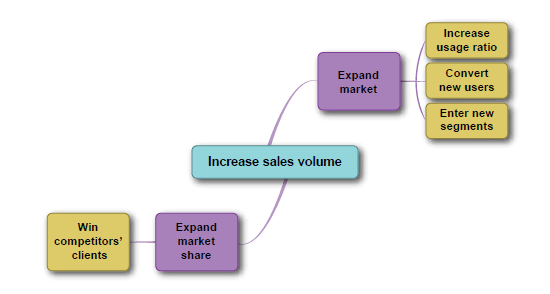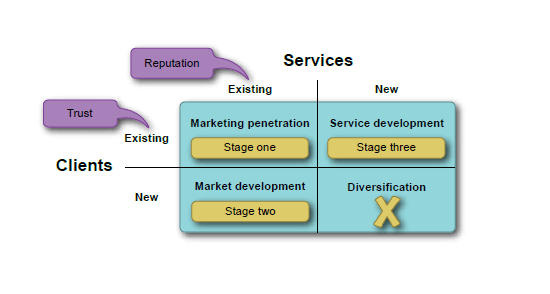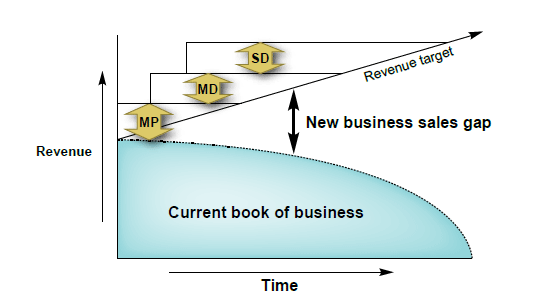Home » BLOG » Business Development » Organic Growth Strategies: Back to Basics
Organic Growth Strategies: Back to Basics
Published in The Cambridge Marketing Review
The challenging market conditions of the last four years mean that organic growth is a significant issue for many organisations. My own practice is focused on the professional service sector and commercial law firms in particular. This particular market has suffered from the pincer squeeze of economic recession together with the deregulation of the legal services industry (as a consequence of the Legal Services Act 2007). Increased competitive pressures created by new (non-law firm) entrants and the rise of substitute products have combined with sluggish market conditions to create the perfect storm. One consequence has been an increase in law firm failures and a sharp upturn in merger activity as forces for market consolidation come fully to bear. This consolidation activity means that some firms are achieving scale very quickly through inorganic means. However, the need for strategies to deliver genuine organic growth remains high across the market.
In considering the subject of growth through the eyes of the marketing strategist we will most closely focus on revenue growth and strategies for achieving this by taking both external and internal perspectives.
Expressed mathematically, revenue growth has two drivers:
| Change in Revenues | = | Change in Sales Volume |
| x | ||
| Change in Unit Price |
For revenue growth to maintain an upwards trajectory, changes on the other side of the equation must be net positive. This does not mean that sales volume and unit prices must both increase but one certainly has to. If the other operand holds steady then revenue will grow. However, if market pressures are such that one decreases then any revenue growth will be arithmetically dependent on the magnitude of the positive movement of the other, whether it be volume or price changes.
It is logical, therefore, that we consider these two components of revenue growth separately in order to generate appropriate strategic options and develop our thinking.
Increasing Sales Volumes: A Strate gic Perspective
Considered at the top level, there are a limited number of ways in which sales volumes can be increased. These are illustrated in figure 1. Taking the two primary options, one can either develop strategies to expand the market for the organisation’s services or one can expand current market share in existing markets.
Figure 1

In practical terms, of course, a strategist will consider the most effective way of prioritising resources and may well develop an approach which seeks to address both routes for growth, albeit with differing levels of priority and emphasis.
Expan the Market
Strategies for expanding the market present a number of possible opportunities for development:
Increase Usage Rate
If usage rate per client can be increased then revenue should grow. Even factoring in the potential for fee discounts to reflect additional volumes of business, strategies to encourage repeat and additional purchases present a route to growth with a high probability of success. This is discussed in more detail later.
Convert New Users
Many firms have under-exploited client bases and a hinterland of potential clients which have not been strategically addressed for their growth potential. Within large client organisations there will often be, for example, multiple purchasers and decision makers which are not being targeted effectively for their revenue giving potential by firms.
Enter New Segments
By entering new segments – whether they be defined by geography, sector or legal practice expertise – the pool in which the firm is fishing increases. Increased opportunity, properly supported in terms of the marketing and sales support activities, should lead to more growth. The key from a strategic perspective is to select new segments which allow the firm to leverage existing expertise, resources or relationships.
Expan d Market Share
Expanding market share by winning work from competitors presents a range of options, both strategic and tactical.
Win Competitors’ Clients – The Direct Approach
For commercial law firms, the historic security of tenure enjoyed with their corporate clients is fast becoming a thing of the past. One of the largest growth areas in the profession has been the inhouse counsel community – lawyers working within corporates, providing both specific legal advice and managing external law firm relationships (and fee budgets). A feature of the modern corporate client relationship has been the formation of law firm panels, a move towards “horses for courses” in the appointment of firms for specific branches of work, increased transparency, more accountability and the regular tendering or re-tendering of work.
The fluid nature of the client relationship has created significant opportunities for sales-oriented firms to capture additional share. It has also seen those less able, suffering significant fee erosion as previously secure, annuity accounts which had been reliable sources of recurring income for many years, are lost to more aggressive and nimble competitors.
The formalisation of sales initiatives, increasingly sophisticated tender response units and the creation of, for example, pursuit teams to actively target clients of high potential value are all now commonplace within leading firms.
Alongside this increased level of sales activity, the market has also opened up through the lowering of regulatory constraints on competition. Firms are now able to employ the full extended marketing mix in pursuing their strategic objectives. Further growth is being seen by firms wishing to explore new channels to market and the innovative use of e-commerce technologies. The liberalisation of the market is also creating opportunities for nonlaw firm organisations to compete directly for a slice of the UK’s £23 billion legal services market.
Win Competitors’ Clients – through M&A activity
Another option, of course, is to win competitors’ clients by acquiring, or merging with, the competitor. This can be distilled down to the level of targeted recruitment – there is a very active market for “lateral hires” (partners with a client following moving firms) as well as the acquisition of teams – which has been an increasingly important element of many firms’ growth strategies, especially when entering new markets or developing their service lines. Of course, the ultimate expression of these types of strategic approaches is the merger or acquisition of a competitor. Whilst the latter would not be regarded as organic growth, it would be fair to regard an active lateral hiring programme as a valid organic growth strategy.
Marketing Strate gy Options In More Detail
The elegant simplicity of Ansoff’s Product – Market Matrix is often under-appreciated. By distilling marketing strategy down into four generic options, a framework is created which allows decision making to be undertaken with precision and clarity.
An adapted version of the matrix (using a Services – Client notation) is shown in figure 2 which has been supplemented to reflect the market challenges faced by those selling intangible services with a high knowledge content (in this context, legal services).
Figure 2

Proposed by Igor Ansoff in Corporate Strategy (1965), it suggests that any business has four fundamental marketing strategies that it can pursue based around existing and new clients or markets together with existing and new services. The four fundamental marketing strategies may be summarised as:
- Market penetration – sell more existing services to existing clients
- Market development – sell existing services to new clients
- Service development – sell new services to existing clients
- Diversification – sell new services to new clients
This sequence also represents the approach that should be adopted to give the best likelihood of success.
Stage One is Market Penetration. Assuming that there is good satisfaction with existing services among existing clients, it is far easier to expand sales here than to try to break new ground elsewhere.
Interestingly, the Ansoff matrix also predicts that it will be easier to sell existing services (for which one has reputation, track record and market position) to non-clients than to sell new services to existing ones (in which trust may be high but could be outdone by the perceived risk of making a decision to purchase an unproven service). In other words, market development should be prioritised above service development as stages two and three.
The challenge of selling a new service to a new client (i.e. diversification) in sufficiently significant volumes to make a difference to the top line in any substantive way, is recognised as being a slow-burn strategy. Within marketing planning, which typically has a 12-month horizon, such diversification activities are not even considered – they are on the longer term business planning agenda. This is a stage four activity.
Additional Factors for the Professional Service Organisation
The generic application of the matrix works well but there are also additional factors at play in professional services organisations which should influence both strategy and marketing activity. These are the role of reputation, the building of high-trust relationships and the development of cross-selling capabilities.
The Power of Reputation and Trust in Providing Opportunities for Revenue Growth
The psychological power of reputation and track record is a huge purchasing influence in all sectors; within professional services it is pre-eminent. Research consistently demonstrates that the lowering of perceived risk (as evidenced by reputation and track record) and the building of trust are the two most important determinants of success in selling professional services.
This should not be surprising when considered through the eyes of the purchaser – when buying a professional service (for example legal advice) there are factors at play in the mind of the prospective client:
- The service is complex and I am unlikely to understand it fully. This means I will need to trust the professional as I will not be able to judge the quality of the core technical service that I am receiving, perhaps not ever and certainly not until it has been delivered, by which point it is too late to unwind my decision.
- The service is likely to be expensive and I risk being seen as not being a sensible custodian of the company budget if I make a poor quality decision.
- If this all goes wrong there are potentially serious consequences for my business and for me personally.
Given this psychological frame, the desire to make low risk decisions, supported by higher levels of trust between professional and client, are clear.
This fact is clearly evidenced in much professional services’ marketing and communications with credentials featuring heavily, independent rankings, client testimonials and experience rich case studies all being used effectively to reduce the perceived purchase risk. It is also interesting to observe how proxies are used effectively as part of professional firm marketing strategy – these are features which are not part of the core technical offer but which sit alongside it and give the client an impression of core-service quality.
A simple example might be the professional way in which frontof- house operations are conducted as part of the marketing mix. As a matter of absolute fact, this has no direct bearing on the quality of the professional advice delivered but as a matter of perception this quality of approach moulds the client’s belief system about the intangible quality of the professional service.
It follows, therefore, that the next most effective strategy for growing sales is to leverage reputation in selling services to new clients before testing the trust of an existing client with a proposition to introduce a new service for which the firm has no reputation.
Cross -selling: The Holy Grail of Professional Services Marketing
Cross-selling, the introduction of services which are offered by the firm already to a client who does not currently buy them, is the Holy Grail for many law firms. With a client who typically has a need for more than one service, it is all too common for firms to fail to capitalise on the opportunity to cross-sell.
A question that is often asked is: “In this model, where does cross-selling sit?” In truth, cross-selling in the professional services context occupies a hybrid position for many law firm partners. Selling a new service to an existing client where the firm has an established service reputation elsewhere should be sensibly positioned as being more challenging when compared to selling existing services to the same client, but easier than creating a new client relationship.
In many firms the challenges associated with cross-selling of services emanate not from the client’s propensity to purchase but from the politics, attitudes and motivations prevalent within the firm. Much of this is bound up in the historic culture of the profession, reward systems which tend to focus on personal rather than team performance, and a high level of “my client” protectionism which exists in many firms.
A structured approach to client management is the way to ‘shine a light’ on these destructive behaviours and to use the twin levers of transparency and peer pressure to bring about change. Those most enlightened now have active programmes to break down these barriers but, for the majority, significant revenue growth opportunities are missed not through a lack of intellectual recognition but rather an inability to change deep-rooted behaviours and cultural norms.
The Implications for Marketing Strate gy Over Time
Figure 3 sets the Ansoff Matrix against a time line. The important constructs of this diagram are the revenue target and the rate of decline of the current book of business.
Figure 3

The difference between the two at any point is the ‘New Business Sales Gap’. The size of the gap is determined by the degree of stretch in the growth target and the rate at which current business erodes over time.
For firms that are deal-driven and highly transactional in nature, the current book of business will erode quickly. Those with more annuity business will be able to predict cash flow into the future with more certainty. Firms with a project or major disputes focus have a different challenge – cash flow will be predictable but project pipeline management techniques will be needed to ensure that resources are well utilised and that the ‘cliff-face’ effect of one significant matter ending is compensated for by another ramping up.
However, across all firms and all markets, classical strategy theory is unequivocal in its recommendations– initially max-out through market penetration, then move on to market development and finally consider service development in order to maximise short-term revenue growth opportunities.
Creating a Client Development Culture to Drive Revenue Growth
It is fair to say that a focus on growing existing clients was, until relatively recently, considered the least glamorous of the available options in the testosterone-rich but common-sense poor world inhabited by many professionals. Awards, accolades, reputations and rewards could only be achieved by ‘knocking down the doors’ and adding new names to the client roster.
Whether the new-found clients developed into longer term sustainable sources of revenue was rarely measured. In the mind of the partner obsessed with a desire to win new clients (and a commensurately short attention span), how these relationships were subsequently developed was something best left to others far away from the battles at the front-line.
Now a much more balanced approach is, quite rightly, prevalent across professional service firms, with client development recognised as key to enduring success. However, the ‘ownership’ of relationships is still an issue, with the stranglehold exerted by some partners being an effective choke on revenue development.
Get Better at Pricing AND Negotiation : The Leaky Colander
Pricing is the second element of the revenue growth equation. Significant downwards pressure on price since the onset of the recession has meant that increases in volume have been all but wiped out. Many firms are simply running (much) faster to stand still.
It follows that revenue growth can be enhanced in practical terms by focusing hard on pricing and improving negotiation skills. If current conditions mean that price rises cannot be achieved, the objective should at least be to minimise erosion.
Pricing for law firms is increasingly market based. Understanding the market in which they are operating is key if pricing decisions are to be optimal – profit or loss is made at the margin with too few partners appreciating that a fee discount of 5% will erode profit significantly (in pre-recession days by around 20% but today by up to 33%).
What this means in practical terms, in many firms, is that those who negotiate the fee (generally the partner with the client relationship) need to be much more conversant with negotiation techniques and have a clearer understanding of their firm’s key price points. They also need a good working picture of the competitive market for the work that is being negotiated.
It is also not uncommon for firms to triple or quadruple discount their fees – once in the initial negotiation, again by not tracking variances for which an additional fee would be payable, next by inaccurately recording their inputs (i.e. time) for work which is chargeable on that basis and finally by making value judgements as to how much time will be recoverable at the point of raising an invoice and under-billing at that point. Given that such leakage can only come off the profit line, it is surprising how few law firm partners are focused seriously and determinedly on these areas.
A further pricing trend is the move towards fixed fees for particular types of work. The profit equation then moves to the issue of internal efficiency. Revenue growth, in these circumstances, is determined by deciding on the correct price point to meet demand and increase unit sales. In a market where most legal services are poorly differentiated and brands are weak, this is very challenging. The position is exacerbated by the high levels of price transparency afforded by new technologies, the internet, social media and clients’ sharing pricing data through trade forums and the media. In common with all businesses, when perceived differentiation between competing offers is low, decisions tend to be price driven.
For most firms, the price elasticity of demand is very high and even small changes may result in dramatic effects on volumes. There are significant opportunities for the marketer to support pricing through effective brand positioning strategies, genuine added value differentiation (on dimensions which are important to the client) and through the creation of a high trust relationship between client and firm that will support more robust pricing.
Back to Basics: Do the Simple Things Well
Organic revenue growth is difficult in the current economic climate. Firms give themselves the best chance of success by understanding the fundamentals, focusing on getting the basics right and having clear, executable plans. Importantly, there needs to be an understanding that organic growth happens incrementally and across a number of fronts. Consequently an unrelenting focus on implementation is key. The marketing function has a key role to play here, both in setting the strategic agenda and in supporting its effective implementation.
This article was published in March 2013 by the The Cambridge Marketing Review. To read the original article click here.
Search
Categories
Recent Posts
- Fighting fit
- The Challenges Of Leadership Are Different To The Challenges Of Management
- The Cultural Dimensions Of Leveraging Institutional Knowledge
- A knowledge-led approach to business development is key to law firm resilience
- Team Morale Is Directly Linked To The Ability To Deliver Differentiated Client Services
